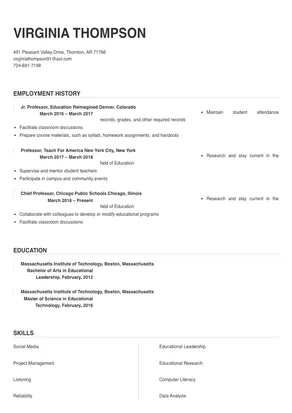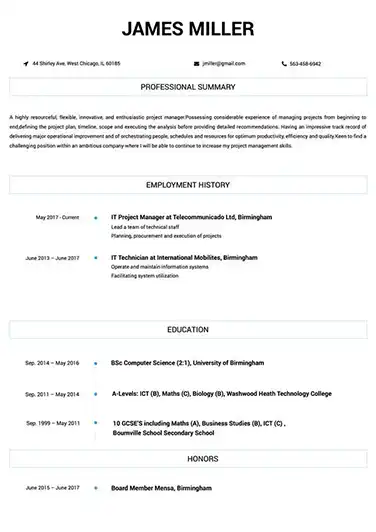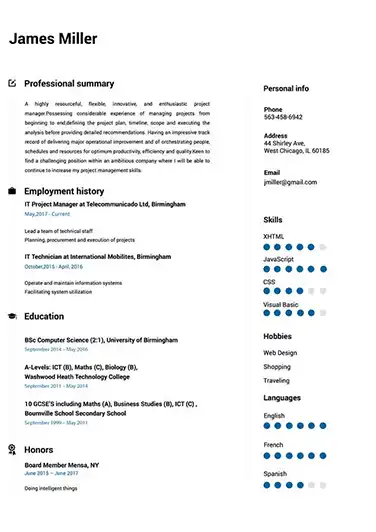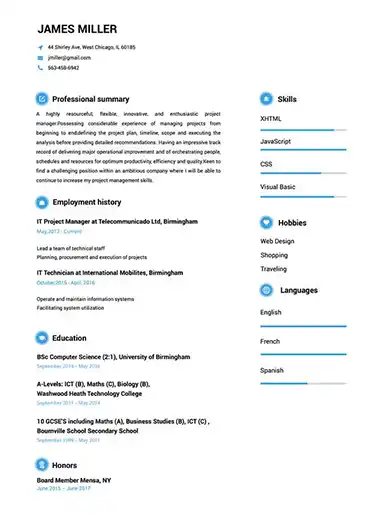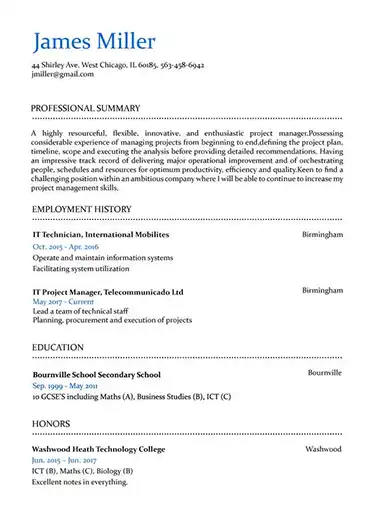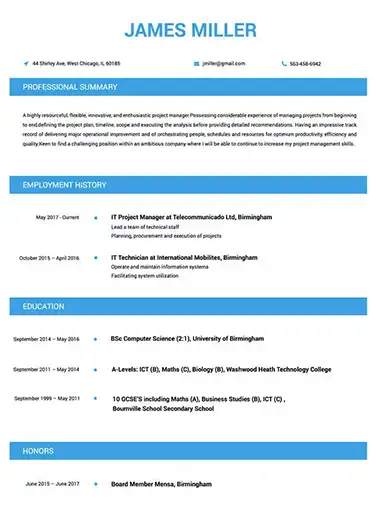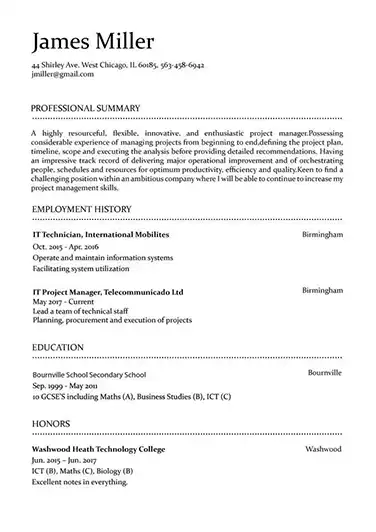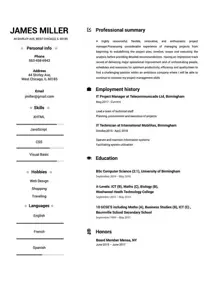 Use This Template
Use This Template
Build your resume in 15 minutes
Create an awesome resume that meets the expectations of potential employers with our selection of professional, field-tested resume templates.
professor: Resume Samples & Writing Guide
virginiathompson91@aol.com
724-691-7198
Employment history
- Research and stay current in the field of Education
- Collaborate with colleagues to develop or modify educational programs
- Facilitate classroom discussions
- Research and stay current in the field of Education
- Supervise and mentor student teachers
- Participate in campus and community events
- Maintain student attendance records, grades, and other required records
- Facilitate classroom discussions
- Prepare course materials, such as syllabi, homework assignments, and handouts
Education
Skills
Do you already have a resume? Use our PDF converter and edit your resume.
jeff-davis@zoho.com
667-293-2261
Employment history
- Prepare and deliver lectures to students
- Maintain student attendance records, grades, and other required records
- Develop and implement course curriculum
Education
Skills
robinsonyvette37@outlook.com
715-349-9064
Professional Summary
Employment history
- Supervise and mentor student teachers
- Teach courses in the field of Education
- Develop and implement course curriculum
- Prepare course materials, such as syllabi, homework assignments, and handouts
- Evaluate and grade students' class work, assignments, and papers
- Collaborate with colleagues to develop or modify educational programs
- Participate in campus and community events
- Develop and implement course curriculum
- Teach courses in the field of Education
Education
Skills
evanskevin@yandex.com
858-421-9543
Employment history
- Prepare and deliver lectures to students
- Maintain student attendance records, grades, and other required records
- Prepare course materials, such as syllabi, homework assignments, and handouts
- Develop and implement course curriculum
- Prepare course materials, such as syllabi, homework assignments, and handouts
- Maintain office hours to meet with students
- Assess student learning and performance
- Teach courses in the field of Education
- Facilitate classroom discussions
Education
Skills
william_grant@protonmail.com
894-182-5945
Employment history
- Participate in faculty and professional meetings
- Facilitate classroom discussions
- Develop and implement course curriculum
- Prepare course materials, such as syllabi, homework assignments, and handouts
- Assess student learning and performance
- Collaborate with colleagues to develop or modify educational programs
- Research and stay current in the field of Education
- Maintain office hours to meet with students
- Advise students on academic and career matters
Education
Skills
Not in love with this template? Browse our full library of resume templates
Creating an effective professor resume presents you with the challenge of appealing to many audiences at once. You’ve got the gatekeepers like ATS (more on what that is later) and university hiring managers as well as other professors in the relevant department.
If your resume is too technical or academic, the hiring managers may struggle with it, but if it’s too focused on them, your academic expertise might be questioned by the department.
Before you start worrying, read our guide. It’s got expert tips to help you craft a resume which balances all of these audiences to get you the professor position you want.
What you’ll learn in this guide:
- How to use professor resume examples to get inspired
- What you can do to prepare for ATS
- How to create a resume recruiters and hiring managers will love
- The proper formatting rules to follow
- How to make your achievements more impactful
- Which skills to include
- How to start with a great objective or summary
- Why targeting your resume makes such a difference
- How to use a resume builder to make the process easier
Professor resume examples to get you started
As an academic professional, a core part of your job is reading journals and generally keeping up with the latest industry scholarship. But when it comes to creating a resume, most professors simply update the old one they already have.
The problem is that this is a bit like publishing a paper without being familiar with the latest research on the topic. You risk looking out of touch and that you skipped a critical step. That’s why before you start writing, you should analyze some quality professor resume examples for ideas and inspiration.
Below, we’ve compiled a few examples for you. As you examine them, be sure to begin listing what stands out and which elements you’d like to incorporate into your own resume. Also try putting yourself in the shoes of a university recruiter and consider what works and doesn’t work about these examples from their perspective.
[Examples]
How to write a professor resume that will get you through the door
Too many academics simply send off a resume for a professor position and wait to hear back. But understanding the process and preparing for each step will give you a far better chance of getting called in for an interview.
Beyond your resume, also be sure to leverage your professional contacts to learn as much as you can about the position. For example, a university might be looking for someone with expertise in a specific research area or someone with more of a teaching focus. This information will allow you to better tailor your resume (more on that below).
The idea behind this technique is to understand the audiences for your resume and appeal to them. Ironically though, the first audience isn’t always a human HR professional but an algorithm.
Why you need to start by understanding ATS
While they’re more associated with big business, many colleges and universities use Applicant Tracking Systems (ATS) for their hiring. These AI-driven tools are designed to read large numbers of resumes and quickly sort them into those worth reviewing further and those who will be rejected.
Unfortunately, applicants who don’t ensure their resumes are optimized to be read by ATS are highly likely to have their resumes automatically rejected, even if they’re otherwise qualified. The key to ensuring you’re in the former category is understanding how ATS work and following these three rules.
- Only submit your resume as a .pdf, .doc, or .docx. These are the three file types that most ATS are designed to read so submitting anything else is likely to lead to an automatic rejection.
- Use a resume builder. Not all of these files are created equal. The way the data is structured within the file has an enormous impact on how well an ATS can read it. The easiest way to ensure you don’t encounter this problem is to use a resume builder designed specifically to produce ATS-friendly files.
- Use keywords strategically. ATS are given a set of criteria and will look for evidence that you match them on your resume. Knowing what those criteria are and specifically ensuring you include as many of them on your resume as possible is critical. The best way to do that is to simply read the description of the position and list the skills and experience it asks for. Now, try and ensure those keywords end up in your resume whenever possible.
How to give recruiters and hiring managers what they’re looking for
Once you’ve made it past ATS you’ve still got someone from HR to impress. Think about some of the assignments you’ve seen students turn in, occasionally it seems like they never considered that you, their professor, would ever read it. The assignment is all about the student and ignores its audience. That’s the exact mistake you want to avoid here.
At every step of your resume creation process, consider the recruiter who will be reading it and ask yourself how you can make their job easier. This comes down to structuring the information well (more on that in the next section), editing your writing so it’s concise, and considering what information to include. On that last point, the keyword technique you just used to optimize for ATS will also help ensure your resume is easy for recruiters to read.
How to format a professor resume
Formatting is about more than just what goes where, it’s about controlling the flow of information from your resume to the person reading it. Doing this allows you to get ahead of questions which might arise and emphasize key advantages of you as a candidate.
The primary rule to follow in formatting is to put more important information towards the top. This is why reverse chronological order is best for listing your academic experience, publications etc. However, if there’s a standard practice in your specific academic field, you can default to that.
How long should it be?
Because of the importance of the position you’re applying for, your resume can be a bit longer than average to include all the important information about your academic work. However, do not use this as an excuse to be verbose. Recruiters still have limited time and will not appreciate feeling it was wasted by reading information you could have left out.
So, try and make your resume as short as you can and consider the recruiter throughout. Ask yourself “does this information make my resume better or am I including it out of habit?” This question should guide you in deciding what to add and what to leave out.
Which sections should you consider including?
Again, don’t include all of these sections simply out of habit. Consider which ones will help your resume stand out to recruiters.
- Resume objective or summary
- Work experience
- Achievements
- Publications
- Education
- Hard skills
- Soft Skills
How to highlight your most important achievements
As much as academia focuses on research and knowledge generation for its own sake, the HR professionals from the college or university will have other considerations. They will be looking for candidates who can help further the institution’s goals, whether publishing more, gaining visibility, improving teaching, etc.
That’s one reason why making your achievements concrete and relating them to the goals the reader will have in mind is such an effective strategy. If you can have a recruit thinking “this candidate sounds like they could help us address X issue” you’ll make a better impression. You’ll still need to show off your academic bona fides, but including achievements which appeal to fellow professors and the administration will help you get hired. Let’s see two examples to illustrate how you should phrase these achievements.
Consistently receive high ratings from students.
This “achievement” is simply too vague to carry much weight. A recruiter is likely to read over this and have it barely register.
Obtained an average student rating of 8.7/10 on teaching, 9/10 on responsiveness, and 7.9/10 on difficulty during the 2018-2019 academic year.
Beyond simply giving a recruiter more information, including more details forces them to consider your teaching abilities, reinforcing the idea in their mind. Phrasing your achievements this way also makes you sound reliable, detail oriented, and competent.
What are ideal professor job qualifications and how to list them correctly
Most job listings for a professor will have very specific qualifications. These might be academic credentials like a PhD or work experience in the field. What you need to do is identify what the exact qualifications are for a specific position and ensure it’s easy to see that you meet them. For example, if a PhD is required, don’t forget it to put it next to your name so the recruiter is instantly aware you meet that requirement.
If the core requirements are met via your work experience, you can try putting your current or previous job title next to your name or in a resume objective or summary (more on how to write them below). If there’s a more detailed list of requirements, you can also create a separate section just to list your relevant job qualifications. In either case, your mission is to make checking that you meet them as easy as possible.
How to make your skills stand out
When listing your skills, you should follow the same rules we laid out for your achievements: be specific. Including specific examples of instances when you demonstrated key skills will make them far more impactful and noteworthy relative to simply listing them. This is particularly true for soft skills, as possessing such skills tends to be less obvious.
Applying for grants
Knowledge of grant application systems is a valuable skill for just about any professor, but simply stating that you have it doesn’t mean very much. Let’s see how this skill looks with a practical example included.
Applying for grants
-Completed 24 grant applications in the past 4 years, resulting in 5 projects being successfully funded.
With this example, you can see just what the candidate’s experience looks like and what the results have been. Instead of simply knowing you have some experience with grants, a recruiter or fellow professor reading this can already envision the successfully funded projects which might result from hiring this candidate. You can only unlock the power of that kind of imagination with specifics.
Of course you won’t always have an example to back up a skill, but it’s still best to focus on the skills where you do. It’s also still vitally important to mention as many of the skills listed in the job description as possible without being dishonest.
The best hard skills to include
The skills required will vary tremendously based on the specific field you’re in, but these are some of the hard and soft skills you’ll want to consider mentioning.
- Curriculum development
- Applying for grants
- Research skills
- IRB application experience (if applicable)
- Academic field specific hard skills
The best soft skills to include
- Teaching
- Mentorship
- Academic networking
- Collaboration
- Dependability
- Problem solving
The best way to begin a professor resume
As mentioned, it’s vital to begin your resume with the most important information you need to get across. The most flexible way to do this is with a resume objective or summary.
A resume objective is a single sentence designed to quickly explain who you are and what you hope to achieve with your resume. It should be concise and information dense while still being readable (the last thing you want is a recruiter re-reading your first sentence to understand what you meant to say). Professors often have a reputation for being wordy and overusing dense academic language, so be sure to avoid making those mistakes here.
A resume summary is longer and therefore allows more flexibility in how you use it. However, avoid making the mistake of using this as an excuse to be wordy. A resume summary should still be well-written and to-the-point. Whether you’re starting with an objective or summary, this is your best chance to make a first impression. It’s also a good place to get ahead of questions which might arise elsewhere in your resume. Now let’s see some examples of both to better understand how they can be used effectively.
How to write a resume objective
Your goal here is to be short, punchy, and get right to the point. The reader should come away with a clear idea of you as a candidate. Let’s compare two examples to see that in action.
I’m a History professor with 6 years experiencing teaching courses largely focused on colonial America looking for a new teaching position.
This example shows many of the things you should avoid in a resume objective. On the most basic level, it’s written in the first person and your resume should be entirely in the third person. But more importantly, while it avoids the common problem of vague wording, it focuses on the wrong details. The goal is to make a strong first impression, but this example only really tells the reader what the candidate’s academic focus is. In other words, it’s a missed opportunity. Now let’s compare that to an improved version.
Associate professor with 6 years teaching experience looking to bring an engaging teaching style and important research on race in colonial America to UNC Chapel Hill.
By rewording this objective, it now communicates several key reasons to hire this candidate. Specifically, it starts by making it clear this person meets the minimum requirements for the position before emphasizing how their teaching and research will enhance the university. Even phrasing an objective this way communicates that the candidate is thinking about the whole university community and not just themselves.
How to write a resume summary
The maxim to follow here is “just because it can be longer doesn’t mean it should be longer.” This is why it’s helpful to plan out the main points you want to make in your summary before you start writing it. This will help it stay focused. Anyone reading your summary should come away with a clear idea of the points you’re making. Let’s look at two examples to better understand this in practice.
Professor of communications at Fillmore College (2011-2015) and Auburn University (2015-2019) over the past 8 years, widely respected in the field and published in a number of prestigious journals. Looking for a position to allow a balance between research and teaching responsibilities along with the opportunity for eventual tenure.
This example alternates between providing too much detail (the years when the candidate taught at specific institutions aren’t needed in the summary) and not enough detail (on journal publications). Then, it shifts to focusing entirely on what this candidate wants from the institution which hires them instead of focusing on what they can provide that institution. Granted, the requirements listed are important, but they aren’t the best things to mention at this stage. Let’s compare that to a version with those problems addressed.
Professor of communications with 8 years teaching experience specializing in political communication techniques looking to bring research into how social media is affecting how politics is discussed to the classroom to help UNC Chapel Hill’s students better understand they affect and are affected by social media campaigning.
In this version, the resume summary largely focuses on how the particular research and teaching topic of this candidate will enhance the university’s student body. Details about their publications have been moved to its own section elsewhere on the resume so this argument can be more focused. As a result, the recruiter can come away with a single clear idea about who this candidate is and why they should be considered.
How to target your resume for each application
Considering how intensive the process of hiring a new professor is, you’re not doing your candidacy any favors by sending every college or university an identical resume. Different institutions will be looking for different qualities. One of the single best things you can do to improve your chances of getting hired is to customize your resume to emphasize the qualities each role requires.
Doing that simply means starting with the job description. Analyze it closely and list all the criteria it mentions (you should have already done this for ATS). Next, try researching the institution and using your networks to gather more information about the challenges it faces. Even if those challenges aren’t mentioned in the job description, demonstrating that you can help the institution face them will help your candidacy immensely.
How to make your resume stand out
The last component of an excellent professor resume is the design. You want to use clean and modern design which doesn’t make you look like someone who’ll bore their classes to death with Powerpoint. Even better, good design will make it easier and more pleasant for a recruiter to read through your resume. But if design isn’t your forte, you need to use a tool which does that for you.
Why using a resume builder is so critical
With so many elements to get right, you need all the help you can get when it comes to crafting the perfect professor resume. That’s why using a resume builder is a no-brainer. It gives you easy access to modern design templates, ensures your resume will be ATS-optimized, and gives you a user-friendly platform for crafting custom resumes for each position.
Together, these advantages add up to giving yourself a better chance of getting hired. It shows you’re proactive and ready to find better solutions instead of relying on the way things have always been done, an essential quality in a great professor. So instead of trying to cut corners and just update your old tired Word resume, see the difference Resumebuild.com’s powerful and intuitive features make.
professor Job Descriptions; Explained
If you're applying for an professor position, it's important to tailor your resume to the specific job requirements in order to differentiate yourself from other candidates. Including accurate and relevant information that directly aligns with the job description can greatly increase your chances of securing an interview with potential employers.
When crafting your resume, be sure to use action verbs and a clear, concise format to highlight your relevant skills and experience. Remember, the job description is your first opportunity to make an impression on recruiters, so pay close attention to the details and make sure you're presenting yourself in the best possible light.
professor
- Instruct students individually and in groups, using various teaching methods.
- Subjects taught include audio editing, video editing, web design, and graphic design.
- Softwares: Adobe Audition, Adobe Premiere, Adobe Illustrator, Adobe Photoshop, Adobe InDesign, Adobe Muse, Adobe Dreamweaver, CorelDraw
- Web Languages: HTML, CSS, PHP, MySQL, JQuery, Wordpress
professor
- Marketing Management Basic and Advanced
- Marketing Research
- Services Marketing
- Advertising/Integrated Marketing Communication
- Consumer Behaviour
professor
- Maintain accurate and complete student records as required by administrative policy.
- Provide information for teachers and staff members involved in helping students or graduates identify and pursue employment opportunities.
- Supervise graduate teaching, internship, and research work.
- Teaching for M.Tech and B.Tech students
professor, career externship preparation
- Prepared and facilitated career preparation workshops to students in the H101 Hospitality Services program with a focus on soft skills development
- Provided student accommodations and academic support
- Arranged work placement opportunities that were a good fit for both the student and the employer
- Responded to student concerns and inquiries during their work placement and resolved conflicts when necessary
professor
- Committee for Business Plans for Dr. Lisa, Trade Subject
- Competitions Committee, English Language Olympiad Committee
- Lecionar aulas, buscando englobar teoria e pratica dentro delas;
- Iniciar, facilitar e moderar discussões em sala;
professor Job Skills
For an professor position, your job skills are a key factor in demonstrating your value to the company and showing recruiters that you're the ight fit for the role. It's important to be specific when highlighting your skills and ensure that they are directly aligned with the job requirements, as this can greatly improve your chances of being hired. By showcasing your relevant skills and experience, you can make a compelling case for why you're the best candidate for the job.
How to include technical skills in your resume:
Technical skills are a set of specialized abilities and knowledge required to perform a particular job
effectively. Some examples of technical skills are data analysis, project management, software proficiency,
and programming languages, to name a few.
Add the technical skills that will get hired in your career
field with our simple-to-use resume builder. Select your desired resume template, once you reach the skills
section of the builder, manually write in the skill or simply click on "Add more skills". This will
automatically generate the best skills for your career field, choose your skill level, and hit "Save &
Next."
- Data Analysis
- Project Management
- Computer Literacy
- Technical Writing
- Instructional Design
- Curriculum Development
- Educational Technology
- Learning Management Systems
- Classroom Management
- Assessment Design
- Instructional Strategies
- Instructional Materials
- Assessment Tools
- Learning Theory
- Learning Outcomes
- Educational Research
- Student Evaluation
- Educational Psychology
- Program Evaluation
- Educational Leadership
- Instructional Coaching.
How to include soft skills in your resume:
Soft skills are non-technical skills that relate to how you work and that can be used in any job. Including
soft skills such as time management, creative thinking, teamwork, and conflict resolution demonstrate your
problem-solving abilities and show that you navigate challenges and changes in the workplace
efficiently.
Add competitive soft skills to make your resume stand-out to recruiters! Simply select
your preferred resume template in the skills section, enter the skills manually or use the "Add more skills"
option. Our resume builder will generate the most relevant soft skills for your career path. Choose your
proficiency level for each skill, and then click "Save & Next" to proceed to the next section.
- Communication
- Interpersonal
- Leadership
- Time Management
- Problem Solving
- Decision Making
- Critical Thinking
- Creativity
- Adaptability
- Teamwork
- Organization
- Planning
- Public Speaking
- Negotiation
- Conflict Resolution
- Research
- Analytical
- Attention to Detail
- Self-Motivation
- Stress Management
- Collaboration
- Coaching
- Mentoring
- Listening
- Networking
- Strategic Thinking
- Negotiation
- Emotional Intelligence
- Adaptability
- Flexibility
- Reliability
- Professionalism
- Computer Literacy
- Technical
- Data Analysis
- Project Management
- Customer Service
- Presentation
- Written Communication
- Social Media
- Troubleshooting
- Quality Assurance
- Collaboration
- Supervisory
- Risk Management
- Database Management
- Training
- Innovation
- Documentation
- Accounting
- Financial Management
- Visualization
- Reporting
- Business Acumen
- Process Improvement
- Documentation
- Relationship Management.
How to Improve Your professor Resume
Navigating resume pitfalls can mean the difference between landing an interview or not. Missing job descriptions or unexplained work history gaps can cause recruiters to hesitate. Let's not even talk about the impact of bad grammar, and forgetting your contact info could leave your potential employer hanging. Aim to be comprehensive, concise, and accurate.
Employment history
Education
Skills
Include your Contact Information and Job Descriptions
Missing job descriptions lessens your chances of getting hired.
Key Insights- Employers want to know what you've accomplished, so make sure to include descriptions for all of your previous jobs.
- Keep job descriptions short but don't just list your jobs.
- Never copy-paste a job description to post on your resume. Get inspired and use tools to help you write customized descriptions.
How to Optimize Your professor Resume
Keep an eye out for these resume traps. Neglecting to detail your job roles or explain gaps in your career can lead to unnecessary doubts. Grammar blunders can reflect negatively on you, and without contact information, how can employers reach you? Be meticulous and complete.
jake-patterson@gmail.com
873-430-3492
Employment history
- Supervise and menter student teachers
- Participate in campus and commuinty events
- Participate in faculty and profesional meetings
- Maintian office hour's to meet with student's
- Advise student's on academic's and career matter's
- Prepare course material's, such as syllabi's, homework assignment's, and handout's.
- Maintan office hours to meet with student's
- Prepare course material's, such as syllabi's, homework assignment's, and handout's
- Collaborate with colleague's to develop or modify educational program's
Education
Skills
Correct Grammar and Address Gap Years in Your Resume
Don't leave unexplained gaps in your work history.
Key Insights- When explaining gaps in your employment section, start by being honest.
- Elaborate on the gap and show that you never stopped learning.
- Explain and elaborate any gap in your work history by highlighting new skills.
professor Cover Letter Example
A cover letter can be a valuable addition to your job application when applying for an professor position. Cover letters provide a concise summary of your qualifications, skills, and experience, also it also gives you an opportunity to explain why you're the best fit for the job. Crafting a cover letter that showcases your relevant experience and enthusiasm for the Accounts Payable role can significantly improve your chances of securing an interview.
Thompson virginiathompson91@aol.com
724-691-7198
491 Pleasant Valley Drive, Thornton, AR
71766
Edutopia
Seattle, Washington
Edutopia Hiring Team
I am writing to express my interest in the Chief Professor position at Edutopia. As a Professor with 7 years of experience in Education myself, I believe I have the necessary skills and expertise to excel in this role.
Growing up, I always had a fascination with Curriculum Development. As I pursued my education and gained experience in this field, I realized that this was where I could make the most impact. I have had the opportunity to work on things throughout my career like personal projects and voluntary work, which have developed in me a deep understanding of the challenges and opportunities in this field. I am excited to bring my passion and expertise to the role at and help your organization achieve its goals.
I cannot stress enough how thrilled I am about the chance to join a team of like-minded individuals who share my values and passion for this amazing field. Thank you for considering my application and I hope for the chance to work together.
Best regards,
Virginia Thompson
724-691-7198
virginiathompson91@aol.com
Virginia Thompson
Showcase your most significant accomplishments and qualifications with this cover
letter.
Personalize this cover letter in just few minutes with our user-friendly tool!
Related Resumes & Cover Letters

Build your Resume in 15 minutes
Create an awesome resume that meets the expectations of potential employers with our selection of professional, field-tested resume templates.
